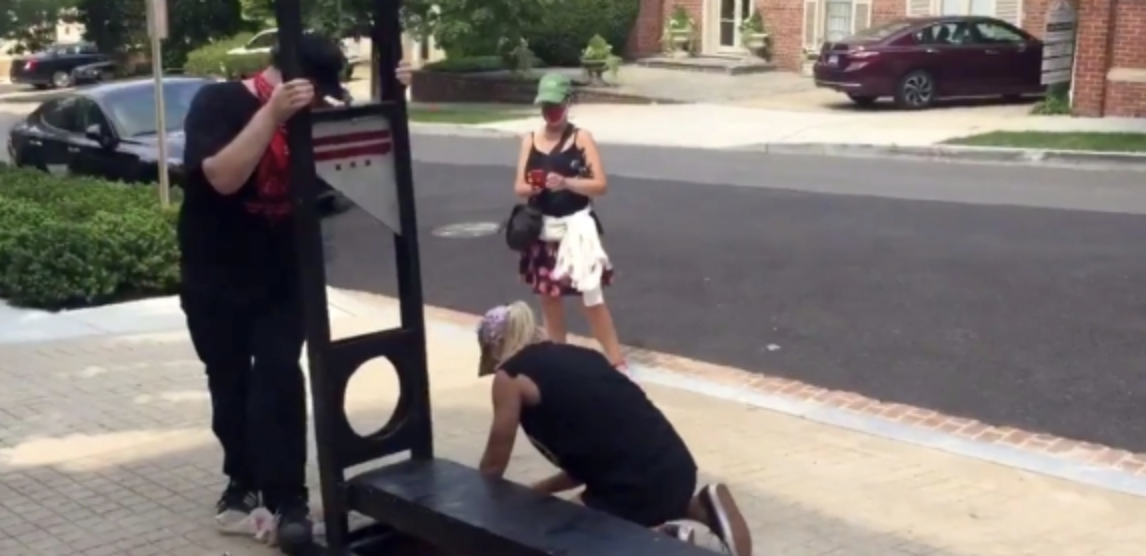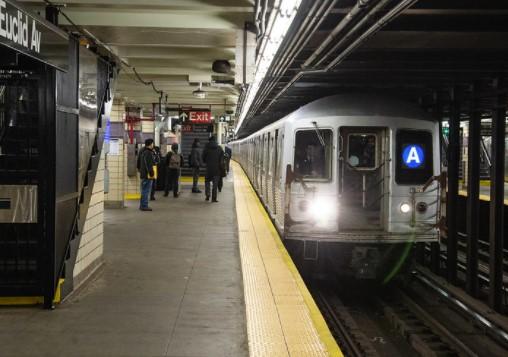Sarah Palin had sued the New York Times for libel, over an editorial (following the wounding of Rep. Steve Scalise by James Hodgkinson) that had referred to the 2011 Jared Loughner shooting of Rep. Gabby Giffords and others:
Describing Loughner’s 2011 attack, the Editorial stated: “[T]he link to political incitement was clear. Before the shooting, Sarah Palin’s political action committee circulated a map of targeted electoral districts that put Ms. Giffords and other Democrats under stylized cross hairs.”
The Editorial contrasted the Loughner attack with that day’s Hodgkinson shooting, where there was “no sign of incitement as direct as in the Giffords attack.” The Editorial did, however, include a hyperlink to an ABC News Article titled Sarah Palin’s ‘Crosshairs’ Ad Dominates Gabrielle Giffords Debate, published the day after Loughner’s 2011 attack, which stated that “[n] o connection has been made between [the Map] and the Arizona shooting.”
The editorial was in error, as the Times later made clear in a series of correction, such as:
An earlier version of this editorial incorrectly stated that a link existed between political incitement and the 2011 shooting of Representative Gabby Giffords. In fact, no such link was established.
And it turns out an earlier version of the editorial, drafted by Elizabeth Williamson, didn’t assert a “link to political incitement”; it was editing by James Bennet, “the editor overseeing opinion journalism at the Times, including masthead editorials by the Times Editorial Board,” that included this “link to political incitement was clear” statement.
Today, Judge Jed Rakoff denied defendants’ motion for summary judgment, which means the case will go to trial, unless the parties settle. The key issue was whether Palin could show “actual malice,” a legal term of art that means knowledge that the statement was false, or recklessness about the statement’s being false.
Judge Rakoff began by asking whether there was enough evidence to go to the jury on whether Bennet (and thus the Times) had “actual malice” as to how readers would understand the statement:
Defendants first argue that plaintiff cannot prove that at the time Bennet wrote the allegedly defamatory portion of the Editorial, he knew that, or was reckless with respect to whether, readers would understand his words in the defamatory sense—that is, that the Map had “directly caused Loughner to shoot his victims.” …
Where a plaintiff’s defamation case depends on a statement that is capable of multiple meanings—one defamatory, the other innocuous—the plaintiff must prove that the defendant acted with actual malice not only with respect to the statement’s falsity but also to its meaning…. [T]he plaintiff must show that the defendant “either deliberately cast its statements in an equivocal fashion in the hope of insinuating a false import to the reader or that it knew and acted with reckless disregard of whether its words would be interpreted by the average reader as a false statement.”
Of course, because actual malice “is a matter of the defendant’s subjective mental state, revolves around facts usually within the defendant’s knowledge and control, and rarely is admitted,” a defendant cannot “automatically insure a favorable verdict by testifying that he published with a belief that the statements were true.” Here, to be sure, Bennet has sworn multiple times that he “did not intend to imply a direct causal link between [the Map] and Loughner’s horrific acts.” He also avers that “it did not occur to [him] that readers would understand the phrase ‘the link to political incitement was clear’ as suggesting that Loughner himself was directly inspired or motivated by the [Map] to engage in the shooting, and [he] did not intend for readers to draw such an inference.” Instead, he claims that he “intended to advance the idea that overheated political rhetoric can create a climate inducive to violent acts, and [he] mentioned the [Map] as an example of the kind of ‘political incitement’ that contributes to this atmosphere.”
However, … the Court cannot automatically credit this testimony at the summary judgment stage…. [P]laintiff meets her burden of adducing evidence that, taken in the light most favorable to plaintiff, could enable a rational jury to conclude that Bennet either knew, or was reckless not to know, that his words would carry the defamatory meaning. Indeed, at least four items of evidence warrant this conclusion.
First, there is the language of the Editorial’s statements themselves, such as the reference to the Map as being a “direct” form of “incitement” to Loughner’s shooting…. Bennet’s contention that, notwithstanding the words he used, he did not mean to suggest a direct link between the Map and the shooting, may be “so inherently improbable that only a reckless man would have” chosen the words he chose to convey the meaning he (allegedly) sought to convey.
Second, Bennet has himself admitted that he was aware that the term “incitement” could mean a call to violence….
Third, Bennet’s decision to substantially revise Williamson’s earlier draft, which did not include the allegedly defamatory language and meaning, is, a jury could find, yet more evidence of actual malice. To be sure, Bennet testified that he made these changes because he worried that phrases like “incendiary” or “inflammatory rhetoric” had been “drained of [their] power because [they are] used so often” and that he was searching for “a very strong word to write about the political climate,” and so chose “political incitement.” But, as discussed above, the credibility of that testimony is for the jury to assess, not for this Court to credit at the summary judgment phase. It is virtually undeniable that Bennet’s edits changed the meaning of Williamson’s draft, an alteration that a reasonable jury might conclude was intentional.
Fourth, the nature of the corrections issued by the Times in the aftermath of the Editorial stand as further circumstantial evidence that Bennet was aware that the Editorial carried the defamatory meaning. As discussed above, upon receiving Douthat’s email expressing concern over the Editorial, Bennet reached out to Williamson and other members of the team and asked them to “get to the bottom of this as quickly as possible.” The team then looked into whether there existed a direct link between the Map and the Loughner shooting; and when it concluded that no such link had been established, the Times issued a correction which read, in part: “An earlier version of this editorial incorrectly stated that a link existed between political incitement and the 2011 shooting of Representative Gabby Giffords. In fact, no such link was established.”
The fact that Bennet and the Times were so quick to print a correction is, on the one hand, evidence that a jury might find corroborative of a lack of actual malice …. But, on the other hand, a reasonable jury could conclude that Bennet’s reaction and the Times’ correction may also be probative of a prior intent to assert the existence of such a direct link, for why else the need to correct? Indeed, the correction itself concedes that Bennet’s initial draft incorrectly stated that there existed such a link. If, as Bennet now contends, it was all simply a misunderstanding, the result of a poor choice of words, it is reasonable to conclude that the ultimate correction would have reflected as much and simply clarified the Editorial’s intended meaning.
Ultimately, while much of plaintiff’s evidence is circumstantial, as is often the case when actual malice is at issue, and while there is arguably contrary evidence as well, the Court finds that, taking the evidence in the light most favorable to plaintiff, she has sufficiently pointed to enough triable issues of fact that would enable a jury to find by clear and convincing evidence that Bennet knew, or was reckless not to know, that his words would convey the meaning in the minds of the readers that plaintiff asserts was libelous, to wit, that she bore a direct responsibility for inciting the Loughner shooting.
Judge Rakoff then went on to conclude that a jury could find that Bennet knew or was reckless about the falsity of the incitement allegation:
[P]laintiff must show that defendants published the libelous statement “with knowledge that it was false or with reckless disregard of whether it was false or not.” “Mere negligence does not suffice.” Instead, “[a] finding of malice must be based on clear and convincing evidence that the defendant in fact entertained serious doubts as to the truth of his publication, or, in the alternative, knew of its falsity.”
While mere failure to conduct an investigation before publishing cannot itself establish actual malice, nonetheless, “where there are obvious reasons to doubt the veracity ” of the information, that can give rise to an inference of actual malice. Thus, as the Ninth Circuit explained, “where [a] publisher undertakes to investigate the accuracy of a story and learns facts casting doubt on the information contained therein, it may not ignore those doubts, even though it had no duty to conduct the investigation in the first place.” That is why, as the Supreme Court has explained, “the purposeful avoidance of the truth is in a different category” from mere failure to investigate….
Plaintiff argues that, construing the evidence in the light most favorable to her, a jury could conclude that (1) Bennet instructed Williamson to research whether there was a link between the Map and the shooting; (2) Bennet conceded, and Williamson confirmed, that her draft embodied the results of that research and did not turn up evidence of a causal link between the Map and the shooting; (3) the hyperlinked article attached to Williamson’s draft recognized as much; and (4) therefore, Bennet “knew there was no link but rewrote the draft anyway to say a link existed—consistent with the narrative he already decided to portray.”
As a threshold matter, defendants insist there is “no evidence to support these assertions.” Specifically, defendants contend that Bennet did not instruct Williamson to research whether there was a link between the map and the shooting; rather, according to defendants, Bennet only “asked for research to determine if the Times’ own Editorial Board had previously written anything connecting the Loughner Shooting to incitement … because he wanted to ensure the new editorial was in sync with any prior Board position.
However, taking the evidence in the light most favorable to plaintiff, Williamson acknowledges in her deposition that Bennet specifically asked her to “look for pieces related to the Giffords shooting and whether there was such a connection.” Defendants suggest that plaintiff is taking these statements out of context, weaving “two strands of testimony into a fiction.” But, again, at the summary judgment phase, the Court finds that Williamson’s deposition testimony could allow a juror to conclude that, at some point during the drafting process, Bennet specifically instructed Williamson to research whether there existed a link between the Map and the shooting and learned that there was no material support for such a link.
Beyond this, Williamson’ s inclusion in her first draft of the hyperlink to the contemporaneous ABC news article that flatly stated there was no such connection would have given Bennet, if he had accessed the article, “obvious reasons to doubt the veracity” of the alleged connection. If so, Bennet’s failure to investigate could support an inference that he purposefully avoided the truth.
To be sure, Bennet maintains that he never clicked on the hyperlink. But under all the circumstances, a jury might discredit this testimony.
Nonetheless, even if it were true, it could be evidence of reckless disregard. After receiving Williamson’s draft, a reasonable jury might conclude, Bennet had obvious reasons to doubt whether there existed a link between the Map and the Loughner shooting. At that point, Bennet’s failure to further investigate or at least just click on the link to the only article Williamson had presented could support the inference that he was purposefully avoiding the truth.
There are other pieces of evidence from the drafting process that further support such a theory. First, as the editors were discussing whether to cover the Hodgkinson shooting, it was Bennet’ s idea to focus the editorial on “the rhetoric of demonization and whether it incites people to this kind of violence.” Then, during the research phase, Bennet asked a researcher to determine whether the Board had previously written “anything connecting to the Giffords shooting to some kind of incitement.” After the researcher sent Bennet an article (written not by the Board but by a columnist at the Times), Bennet replied “Good for us.” While Bennet has testified that he does not recall what he meant by that response, a reasonable jury could infer from this response that Bennet felt free to advance his narrative because the Editorial Board had not written on the subject.
In addition, researchers sent to Bennet other articles that disclaimed the idea that Loughner had been motivated by violent rhetoric. Notably, Bennet was sent an earlier editorial entitled “As We Mourn,” published in January 2011, which quoted President Barack Obama saying Loughner’s shooting cannot be blamed on “a simple lack of civility.” Like the hyperlink, Bennet testified that he did not read this article, even after specifically asking for the researcher to dig up articles of this sort. But, as with the hyperlink, a jury could infer from this a purposeful avoidance of the truth.
Once again, there is considerable evidence that defendants mount to support the notion that Bennet simply drew the innocent inference that a political circular showing crosshairs over a Congressperson’s district might well invite an increased climate of violence with respect to her. But, taken in the light most favorable to plaintiff, the evidence shows Bennet came up with an ang le for the Editorial, ignored the articles brought to his attention that were inconsistent with his angle, disregarded the results the Williamson research that he commissioned, and ultimately made the point he set out to make in reckless disregard of the truth
Accordingly, the Court concludes that there is sufficient evidence to allow a rational finder of fact to find actual malice by clear and convincing evidence.
from Latest – Reason.com https://ift.tt/2EOIjBq
via IFTTT





